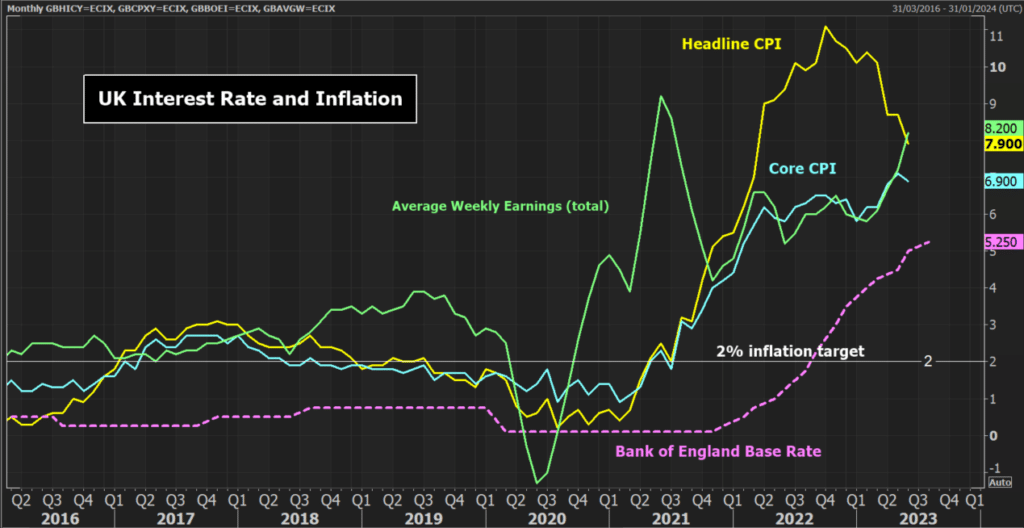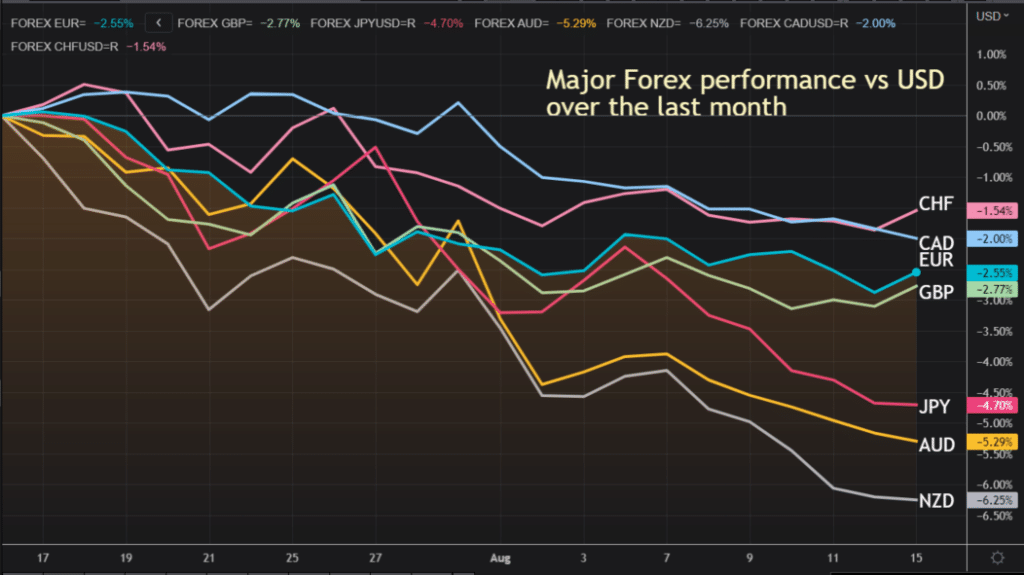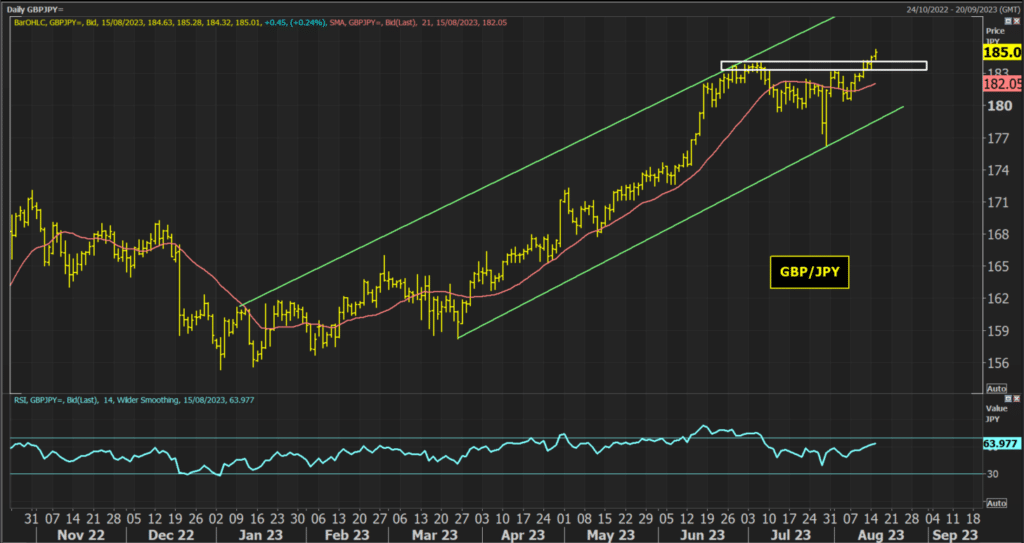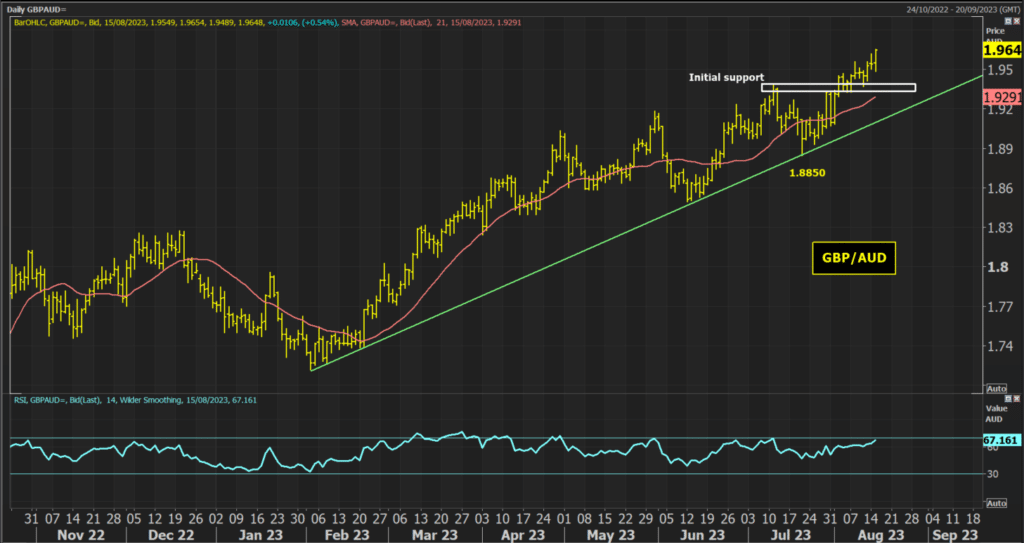The Bank of England (BoE) is squarely focused on still fighting the high levels of inflation that the UK is suffering from. One of the key drivers of inflation is the cost-push forces of wages. The latest data on the UK labour market and wage growth will therefore be causing some furrowed brows down the corridors at the Bank of England. Higher than expected wages will impact the market’s outlook for monetary policy and as a consequence, will impact GBP. However, some GBP major crosses look better to trade than others.
- UK wages are still strong, giving the BoE a headache when it comes to monetary policy
- UK rates are likely to rise again in September and November
- GBP performance remains mixed. Picking the right crosses is important.

Rising UK wages are an issue for the BoE
The Bank of England has an incredibly difficult job on its hands (albeit arguably much of its own making). It is faced with navigating an economy that is bumping along the bottom, just skirting above recession (although it is not alone there). It is faced with one of the consistently highest inflation rates among major economies. The labour market data for June will not give it much comfort either.
According to ONS data, UK Unemployment has unexpectedly increased by two-tenths to 4.2% (when the consensus had expected it to remain steady at 4.0%. Furthermore, and considered to be more important for monetary policy decisions, wage growth has risen to record levels. In the three months to June, average earnings excluding bonuses increased to 7.8% which is the highest level since records began in 2001. Including bonuses, total pay increased by 8.2%.

This gives the Bank of England a considerable quandary. Faced with a stagnant economy and now a jobless rate that is picking up, the perils of a “wage-price” spiral remain of primary concern. Will it need to push the country into recession (by hiking rates more aggressively) to help bring the inflationary pressures back under control?
The BoE has another round of wage data before the September Monetary Policy Committee (MPC) meeting in addition to inflation for July and August. The scale of the problem facing the MPC for the final three meetings of the year will become much clearer then, however, for now, markets are already taking a view.
The impact on the Bank of England’s rates path
The strength of wage growth is a significant problem for the Bank of England. With wages rising again (and being revised higher last month) it is clear that the UK is still unable to escape the inflationary pressures of the labour market. The BoE will therefore need to hike rates again. The big question is how much.
Markets have been hovering around a peak rate of 5.75% since the inflation rate for June surprised to the downside last month. However, this wage data has pushed the peak rate back towards 6.00% again. That means an expectation of around three more 25bps hikes by March. A 25bps hike is the minimum we can expect in September, and if so then another 25bps in November.
However, the BoE has also got form (although only recently) in looking to front-load hikes. It could be that if the CPI data reverts to surprising to the upside and wages remain hot again next month, there could be a 50bps hike in September.
All of this is speculation in front of the data. However, speculation is also helping to support GBP now.
GBP with a mixed outlook on major crosses
GBP is being supported but this renewed speculation of further rate hikes. Looking at the performance of all major currencies versus the USD, we see that the currencies that have central banks on hold (AUD, NZD, and JPY) are underperforming (deteriorating risk appetite is playing into the AUD and NZD moves, with higher US yields weighing on JPY). The European currencies (GBP, EUR and CHF) are all with central banks still with hikes in the pipeline and they are performing better (albeit still negative versus the USD).

It suggests that GBP is struggling versus the USD, is mixed versus the EUR, and performing better versus AUD and JPY. This is reflected in the charts too. When it comes to GBP long positions, the GBP/JPY and GBP/AUD crosses look to have the most upside potential.
Technical analysis shows that GBP/JPY has broken decisively higher through the resistance at 183.25/184.00. Today’s move is confirming a break to levels not seen since December 2015. The next important resistance is not until 189. The daily Relative Strength Index (RSI) is building strongly once more, with a move into the mid-60s. Given the RSI spent much of June well above 70, there is plenty of upside potential for the price to run higher now..

Momentum is again very strong for GBP long positions on GBP/AUD, with the RSI up in the high 60s. The breakout above 1.9390 had its pullback at the end of last week and the cross has just used this as a springboard for further gains. The pair is trading around its highest since April 2020 and there is very resistance until moves above the 2.0000 big figure psychological barrier. I believe that the initial support band between 1.9330/1.9390 is now a great platform to launch new long positions if there is a near-term unwind.
